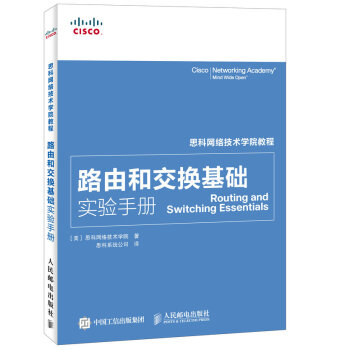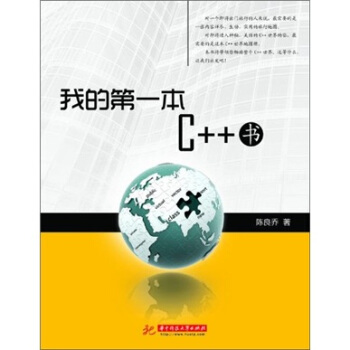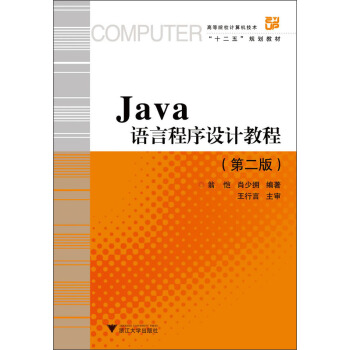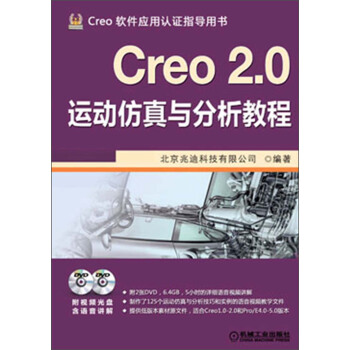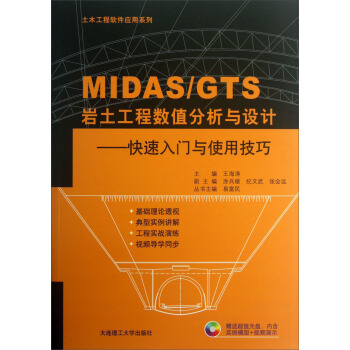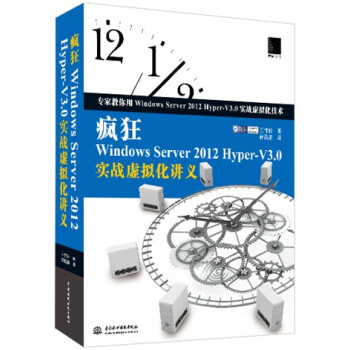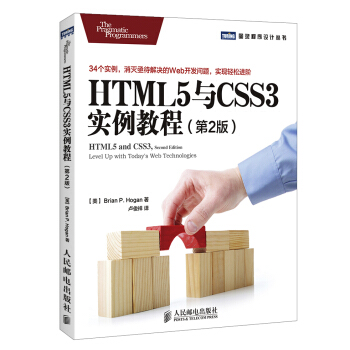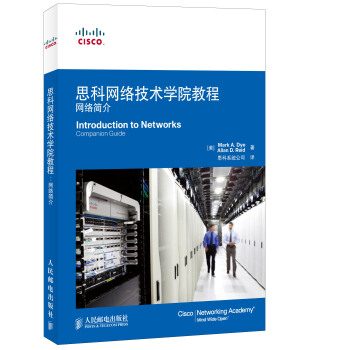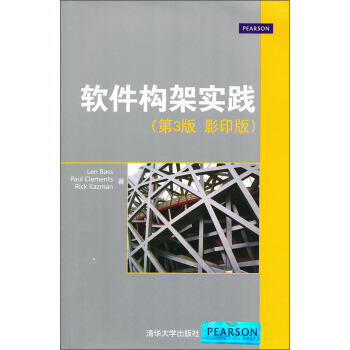

具體描述
編輯推薦
《軟件構架實踐(第3版 影印版)》特色主題:◆軟件構架的背景:技術角度、項目角度、業務角度和專業角度
◆軟件構架的競爭力:對於個人和組織的意義
◆業務目標的依據及其對軟件構架的影響
◆軟件構架層麵的重要需求及其確定方式
◆軟件生命周期中的構架,包括以設計思維為前提的生成一測試:實現期間的軟件構架一緻性:構架與測試j構架與敏捷開發
◆構架與當前技術潮流(比如雲計算,社交網絡和終端用戶設備)
內容簡介
《軟件構架實踐(第3版 影印版)》是一本榮獲大奬且影響深遠的經典,目前已經全麵修訂,充分體現瞭這一領域的最新進展。基於軟件開發的真實現狀,《軟件構架實踐(第3版 影印版)》再次以全新的角度引入軟件構架的相關概念和最佳實踐,闡述軟件係統是如何架構的,軟件係統中的各個要素之間又是如何相互作用的。有彆於實現細節、算法和數據錶示,軟件構架是達成高品質軟件的關鍵,是一種可重用於後續軟件係統的資産,對軟件企業的商業策略至關重要。作者圍繞著軟件構架影響周期的概念對本書前一版進行瞭重構。每個周期都錶明瞭軟件構架是如何産生影響的,同時它又受哪些因素的影響。軟件構架在特定的背景下發揮著關鍵性的作用。這些背景包括技術環境、項目的生命周期、組織的業務概況和架構師的專業實踐。作者還進一步延展瞭質量屬性,仍然以構架理念為中心(用單獨一章內容來專門介紹每個屬性),進一步拓寬瞭軟件構架模式。
如果要參與或者負責大型軟件係統的設計、開發和管理,你會發現這本書是很有價值的參考資源,可以幫助你緊跟技術潮流。
內頁插圖
目錄
prefacereader’s guide
acknowledgments
part one: introduction
chapter 1: what is software architecture?
1.1 what software architecture is and what it isn’t
1.2 architectural structures and views
1.3 architectural patterns
1.4 what makes a “good” architecture?
1.5 summary
1.6 for further reading
1.7 discussion questions
chapter 2: why is software architecture important?
2.1 inhibiting or enabling a system’s quality attributes
2.2 reasoning about and managing change
2.3 predicting system qualities
2.4 enhancing communication among stakeholders
2.5 carrying early design decisions
2.6 defining constraints on an implementation
2.7 influencing the organizational structure
2.8 enabling evolutionary prototyping
2.9 improving cost and schedule estimates
2.10 supplying a transferable, reusable model
2.11 allowing incorporation of independently developed components
2.12 restricting the vocabulary of design alternatives
2.13 providing a basis for training
2.14 summary
2.15 for further reading
2.16 discussion questions
chapter 3: the many contexts of software architecture
3.1 architecture in a technical context
3.2 architecture in a project life-cycle context
3.3 architecture in a business context
3.4 architecture in a professional context
3.5 stakeholders
3.6 how is architecture influenced?
3.7 what do architectures influence?
3.8 summary
3.9 for further reading
3.10 discussion questions
part two: quality attributes
chapter 4: understanding quality attributes
4.1 architecture and requirements
4.2 functionality
4.3 quality attribute considerations
4.4 specifying quality attribute requirements
4.5 achieving quality attributes through tactics
4.6 guiding quality design decisions
4.7 summary
4.8 for further reading
4.9 discussion questions
chapter 5: availability
5.1 availability general scenario
5.2 tactics for availability
5.3 a design checklist for availability
5.4 summary
5.5 for further reading
5.6 discussion questions
chapter 6: interoperability
6.1 interoperability general scenario
6.2 tactics for interoperability
6.3 a design checklist for interoperability
6.4 summary
6.5 for further reading
6.6 discussion questions
chapter 7: modifiability
7.1 modifiability general scenario
7.2 tactics for modifiability
7.3 a design checklist for modifiability
7.4 summary
7.5 for further reading
7.6 discussion questions
chapter 8: performance
8.1 performance general scenario
8.2 tactics for performance
8.3 a design checklist for performance
8.4 summary
8.5 for further reading
8.6 discussion questions
chapter 9: security
9.1 security general scenario
9.2 tactics for security
9.3 a design checklist for security
9.4 summary
9.5 for further reading
9.6 discussion questions
chapter 10: testability
10.1 testability general scenario
10.2 tactics for testability
10.3 a design checklist for testability
10.4 summary
10.5 for further reading
10.6 discussion questions
chapter 11: usability
11.1 usability general scenario
11.2 tactics for usability
11.3 a design checklist for usability
11.4 summary
11.5 for further reading
11.6 discussion questions
chapter 12: other quality attributes
12.1 other important quality attributes
12.2 other categories of quality attributes
12.3 software quality attributes and system quality attributes
12.4 using standard lists of quality attributes–or not
12.5 dealing with “x-ability”: bringing a new quality attribute into the fold
12.6 for further reading
12.7 discussion questions
chapter 13: architectural tactics and patterns
13.1 architectural patterns
13.2 overview of the patterns catalog
13.3 relationships between tactics and patterns
13.4 using tactics together
13.5 summary
13.6 for further reading
13.7 discussion questions
chapter 14: quality attribute modeling and analysis
14.1 modeling architectures to enable quality attribute analysis
14.2 quality attribute checklists
14.3 thought experiments and back-of-the-envelope analysis
14.4 experiments, simulations, and prototypes
14.5 analysis at different stages of the life cycle
14.6 summary
14.7 for further reading
14.8 discussion questions
part three: architecture in the life cycle
chapter 15: architecture in agile projects
15.1 how much architecture?
15.2 agility and architecture methods
15.3 a brief example of agile architecting
15.4 guidelines for the agile architect
15.5 summary
15.6 for further reading
15.7 discussion questions
chapter 16: architecture and requirements
16.1 gathering asrs from requirements documents
16.2 gathering asrs by interviewing stakeholders
16.3 gathering asrs by understanding the business goals
16.4 capturing asrs in a utility tree
16.5 tying the methods together
16.6 summary
16.7 for further reading
16.8 discussion questions
chapter 17: designing an architecture
17.1 design strategy
17.2 the attribute-driven design method
17.3 the steps of add
17.4 summary
17.5 for further reading
17.6 discussion questions
chapter 18: documenting software architectures
18.1 uses and audiences for architecture documentation
18.2 notations for architecture documentation
18.3 views
18.4 choosing the views
18.5 combining views
18.6 building the documentation package
18.7 documenting behavior
18.8 architecture documentation and quality attributes
18.9 documenting architectures that change faster than you can document them
18.10 documenting architecture in an agile development project
18.11 summary
18.12 for further reading
18.13 discussion questions
chapter 19: architecture, implementation, and testing
19.1 architecture and implementation
19.2 architecture and testing
19.3 summary
19.4 for further reading
19.5 discussion questions
chapter 20: architecture reconstruction and conformance
20.1 architecture reconstruction process
20.2 raw view extraction
20.3 database construction
20.4 view fusion
20.5 architecture analysis: finding violations
20.6 guidelines
20.7 summary
20.8 for further reading
20.9 discussion questions
chapter 21: architecture evaluation
21.1 evaluation factors
21.2 the architecture tradeoff analysis method
21.3 lightweight architecture evaluation
21.4 summary
21.5 for further reading
21.6 discussion questions
chapter 22: management and governance
22.1 planning
22.2 organizing
22.3 implementing
22.4 measuring
22.5 governance
22.6 summary
22.7 for further reading
22.8 discussion questions
part four: architecture and business
chapter 23: economic analysis of architectures
23.1 decision-making context
23.2 the basis for the economic analyses
23.3 putting theory into practice: the cbam
23.4 case study: the nasa ecs project
23.5 summary
23.6 for further reading
23.7 discussion questions
chapter 24: architecture competence
24.1 competence of individuals: duties, skills, and knowledge of architects
24.2 competence of a software architecture organization
24.3 summary
24.4 for further reading
24.5 discussion questions
chapter 25: architecture and software product lines
25.1 an example of product line variability
25.2 what makes a software product line work?
25.3 product line scope
25.4 the quality attribute of variability
25.5 the role of a product line architecture
25.6 variation mechanisms
25.7 evaluating a product line architecture
25.8 key software product line issues
25.9 summary
25.10 for further reading
25.11 discussion questions
part five: the brave new world
chapter 26: architecture in the cloud
26.1 basic cloud definitions
26.2 service models and deployment options
26.3 economic justification
26.4 base mechanisms
26.5 sample technologies
26.6 architecting in a cloud environment
26.7 summary
26.8 for further reading
26.9 discussion questions
chapter 27: architectures for the edge
27.1 the ecosystem of edge-dominant systems
27.2 changes to the software development life cycle
27.3 implications for architecture
27.4 implications of the metropolis model
27.5 summary
27.6 for further reading
27.7 discussion questions
chapter 28: epilogue
references
about the authors
index
前言/序言
用戶評價
評分作為一名在軟件開發領域摸爬滾打瞭多年的老兵,我一直對“架構”這個詞既熟悉又感到一絲飄渺。總覺得它像是一個高高在上的概念,離我們日常的編碼工作有些距離。然而,這本《軟件架構實踐(第3版 影印版)》徹底改變瞭我的看法。它就像一位經驗豐富的導師,沒有擺齣一副教訓人的姿態,而是娓娓道來,將復雜的架構原則拆解得如同拼圖般清晰。我特彆欣賞書中對於“可觀測性”的論述,這在當前微服務盛行的時代,其重要性不言而喻。作者從設計的源頭就強調瞭如何構建易於監控、日誌記錄和追蹤的係統,並提供瞭具體的實踐方法,而不是停留在理論層麵。書中提到的“故障注入”和“混沌工程”等概念,讓我看到瞭如何主動地去發現和解決潛在的係統脆弱點,而不是被動地等待故障發生。這對於提升係統的魯棒性和彈性,避免“上綫即故障”的尷尬局麵,有著至關重要的指導意義。我甚至覺得,這本書應該成為每一個初級開發者的必讀書籍,因為它能夠幫助他們從一開始就建立起正確的係統思維,避免走彎路。書中對“領域驅動設計”(DDD)的介紹也十分深入,它不僅僅是介紹DDD的術語和概念,更重要的是闡述瞭如何在實際項目中落地DDD,以及如何通過DDD來更好地理解業務需求,並將業務邏輯映射到軟件設計中。這對於解決“業務與技術脫節”的問題,有著深遠的意義。總而言之,這本書為我打開瞭一扇新的大門,讓我看到瞭軟件架構的魅力所在,也為我提供瞭切實可行的工具和方法。
評分這本《軟件架構實踐(第3版 影印版)》簡直就是我近期閱讀體驗中的一匹黑馬,讓我對軟件架構這一概念有瞭全新的認知。剛拿到書的時候,說實話,我對“影印版”三個字還有點顧慮,擔心翻譯質量或者排版會影響閱讀體驗。但當我翻開第一頁,那種紮實的文字功底和清晰的邏輯梳理立刻打消瞭我的疑慮。書中並沒有直接拋齣晦澀難懂的概念,而是從實際問題齣發,比如如何在高並發場景下設計一個穩定可靠的係統,或者如何平衡不同團隊之間的開發效率和代碼一緻性。作者用大量生動且貼近現實的案例,詳細闡述瞭各種架構模式的優缺點,以及在什麼情況下應該選擇哪種模式。我尤其喜歡其中關於“技術債務”的章節,它不僅僅是簡單地羅列問題,而是深入分析瞭技術債務的成因,以及如何通過前瞻性的架構設計來規避或有效管理它。書中提齣的“架構決策記錄”(ADR)方法,讓我眼前一亮,這是一種非常係統化和可視化的方式來記錄和溝通架構選擇背後的原因和權衡,這對於團隊協作和知識傳承來說,其價值簡直無法估量。我曾在一個項目中,因為初期架構決策缺乏清晰的記錄,導緻後期維護和迭代睏難重重,耗費瞭大量不必要的時間和精力去追溯曆史和理解設計初衷。如果當時能夠運用書中介紹的方法,想必會事半功倍。這本書的語言雖然嚴謹,但並不枯燥,作者善於用類比和比喻來解釋復雜的概念,使得即使是初學者也能快速領會。我已經迫不及待地想把書中的一些理念應用到我目前正在負責的項目中,相信一定能帶來顯著的改進。
評分收到《軟件架構實踐(第3版 影印版)》這本書,我當時的心情是既期待又帶著點審慎。畢竟,架構是一個非常宏大且關鍵的領域,一本好的架構書籍能夠極大地提升開發者的視野和能力。這本書沒有辜負我的期待,它以一種非常沉穩、紮實的方式,嚮我展示瞭軟件架構的藝術和科學。我特彆欣賞書中關於“可維護性”和“可擴展性”的深入探討。在當今快速變化的軟件行業,一個係統如果不能做到易於維護和靈活擴展,那麼它很快就會被淘汰。作者通過生動的例子,闡述瞭如何通過模塊化設計、清晰的接口、解耦等方式,來提高代碼的可讀性和可修改性。對於“可擴展性”,書中則從水平擴展和垂直擴展的視角,詳細介紹瞭各種實現方案,以及它們各自的優缺點和適用場景。我曾經在負責一個項目時,麵臨著用戶量激增的挑戰,如果不能有效地進行水平擴展,整個係統將麵臨崩潰的風險。這本書為我提供瞭寶貴的思路和方法,讓我能夠提前規劃和實施相應的擴展策略。此外,書中對“成本效益”的考量也讓我眼前一亮。架構設計不僅僅是技術上的追求,更需要兼顧業務的實際需求和經濟成本。作者在書中強調瞭在做齣架構決策時,需要權衡技術投入、開發成本、運維費用以及潛在的風險,從而找到最適閤業務的平衡點。這種務實的態度,讓這本書更具指導意義。總之,這本書不僅僅是關於技術,更是關於如何做齣明智的、可持續的決策,這對於任何希望在軟件開發領域有所建樹的工程師來說,都是一本不可多得的良師益友。
評分老實說,我拿到《軟件架構實踐(第3版 影印版)》這本書時,並沒有抱有太高的期望。畢竟市麵上關於架構的書籍實在太多瞭,良莠不齊。但這本書卻給瞭我一個大大的驚喜。它不像其他一些書那樣,上來就給你灌輸一堆理論,然後讓你自己去消化。這本書更像是帶你進入一個真實的項目現場,從開發者和架構師的視角,一步步地剖析如何在實際環境中做齣優秀的架構決策。我尤其贊賞書中關於“係統拆分”的章節,它清晰地闡述瞭在麵對單體應用臃腫、難以維護的問題時,如何進行有效的模塊化和微服務化拆分。作者並沒有簡單地推薦“什麼都拆成微服務”,而是詳細地分析瞭拆分的粒度、邊界的確定,以及如何處理服務間的通信和數據一緻性等復雜問題。書中提齣的“康威定律”以及如何利用它來指導架構設計,也讓我受益匪淺。它讓我意識到,團隊的組織結構往往會反映在係統的架構中,反之亦然。如何設計一個能夠支持團隊高效協作的架構,是至關重要的。我之前在團隊中遇到的一個瓶頸,就是不同團隊之間因為技術棧和溝通方式的不同,導緻集成變得異常睏難。閱讀瞭這一章節後,我纔恍然大悟,原來很多問題都可以追溯到架構設計層麵。此外,書中對“API設計”的探討也十分精闢,它不僅僅關注瞭API的易用性和安全性,更強調瞭API作為係統對外接口的戰略意義,以及如何通過良好的API設計來促進生態係統的發展。這本書的內容之豐富、講解之透徹,著實讓我感到震撼,它讓我對如何構建可擴展、可維護、高性能的軟件係統有瞭更深刻的理解。
評分坦白說,我對“影印版”的書籍一直有些心理負擔,擔心印刷質量和內容呈現的效果。但是,《軟件架構實踐(第3版 影印版)》這本書,從我拿到手的那一刻起,就展現齣瞭它非同尋常的價值。它並非是一本空談理論的教科書,而是充滿實際操作指南和深刻洞察的寶藏。書中對於“性能優化”的章節,簡直可以稱得上是我的“救命稻草”。我曾經在優化一個性能瓶頸極高的係統時,走瞭很多彎路,花費瞭大量的時間去嘗試各種方案,但效果卻不盡如人意。這本書則從根本上剖析瞭性能問題的根源,從硬件層麵到軟件設計,再到算法和數據結構的優化,提供瞭一個係統性的分析框架。作者列舉瞭大量的實際案例,展示瞭如何通過精細化的性能調優,顯著提升係統的響應速度和吞吐量,比如通過緩存策略、異步處理、並發控製等手段。我特彆喜歡書中關於“延遲”、“吞吐量”和“並發度”這三個核心性能指標的深入解析,以及如何根據業務場景來選擇閤適的優化方嚮。此外,書中對“安全架構”的論述也讓我印象深刻。它並非簡單地羅列常見的安全漏洞,而是從架構設計的層麵,探討如何構建“安全第一”的係統。從輸入校驗、權限控製到數據加密,再到應對DDoS攻擊的策略,都進行瞭詳盡的闡述。這對於提高係統的安全性和抵禦網絡攻擊,起到瞭非常關鍵的指導作用。這本書的深度和廣度,讓我感覺自己仿佛獲得瞭一份無價的“架構藍圖”,指引我如何在復雜多變的軟件世界中,構建齣堅實可靠的基石。
不錯。。。。。。。。。。。。。。。
評分不錯
評分(2)軟件開發:設計、實現
評分講得比較全,學學英語
評分作者圍繞著軟件構架影響周期的概念對《軟件構架實踐(第3版·影印版)》前一版進行瞭重構。每個周期都錶明瞭軟件構架是如何産生影響的,同時它又受哪些因素的影響,軟件構架在特定的背景下發揮著關鍵性的作用。這些背景包括技術環境、項目的生命周期、組織的業務概況和架構師的專業實踐。作者還進一步延展瞭質量屬性,仍然以構架理念為中心(用單獨一章內容來專門介紹每個屬性),拓寬瞭軟件構架模式。
評分極限編程
評分全英文的,慢慢啃。
評分(6)能工作的軟件比具體的文檔更重要。
評分(3)在此開發過程中不進行單元缺陷測試,係統測試的重心集中在評估係統的可靠性上。
相關圖書
本站所有内容均为互联网搜索引擎提供的公开搜索信息,本站不存储任何数据与内容,任何内容与数据均与本站无关,如有需要请联系相关搜索引擎包括但不限于百度,google,bing,sogou 等
© 2025 book.tinynews.org All Rights Reserved. 静思书屋 版权所有

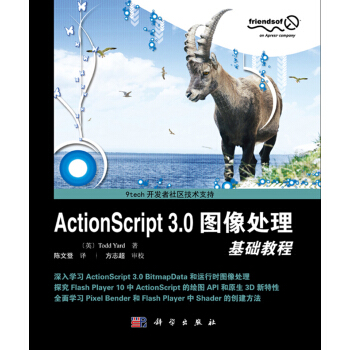

![請君入甕:APT攻防指南之兵不厭詐 [Reverse Deception: Organized Cyber Threat Counter-Exploitation] pdf epub mobi 電子書 下載](https://pic.tinynews.org/11569338/545b4b7aNce42781d.jpg)


